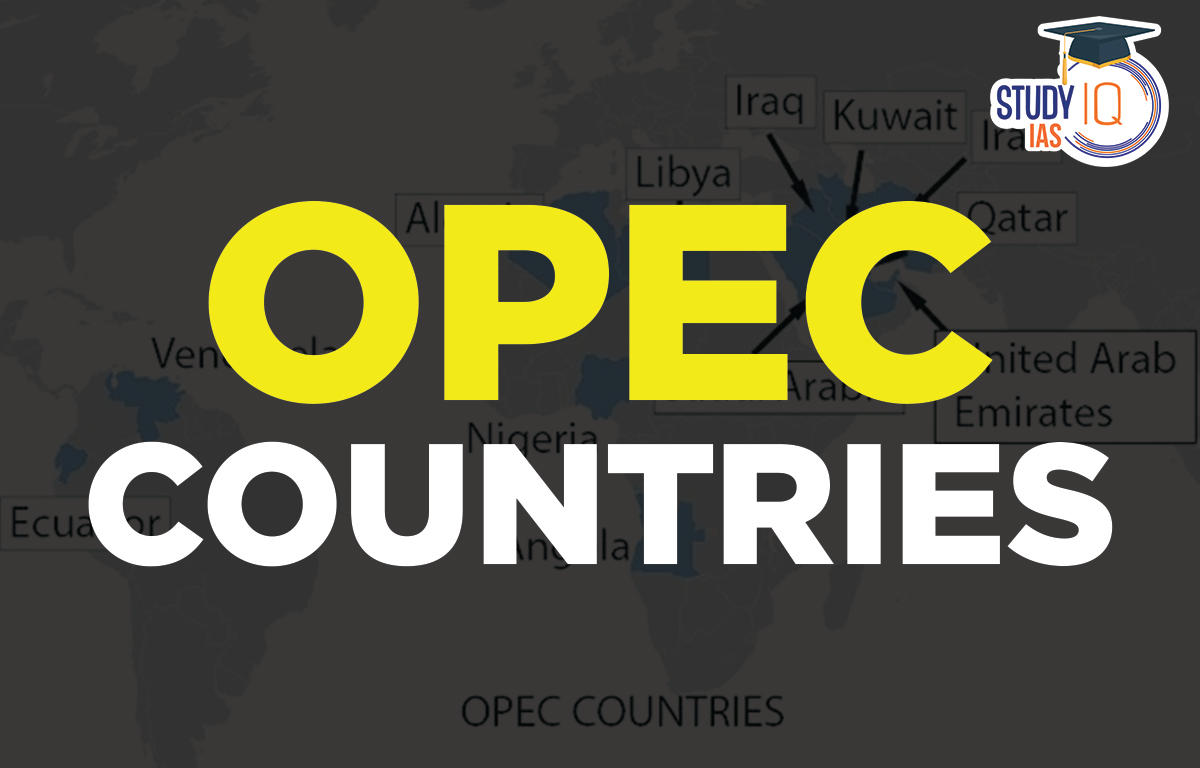Table of Contents
Organization of the Petroleum Exporting Countries (OPEC)
Organization of the Petroleum Exporting Countries is known as OPEC. It is an ongoing intergovernmental entity. It was established at the Baghdad Conference in September 1960 by Kuwait, Venezuela, Iran, and Iraq. There are now 13 people on it. The company’s main office is in Vienna, Austria.
The goal of OPEC is to stabilize the oil supply in order to prevent price volatility that could harm the economies of both oil-producing and -consuming nations. Any nation that is a major oil exporter is eligible to join OPEC.
Its headquarters were first located in Geneva, Switzerland, before being transferred to Vienna, Austria, in 1965. It supplies 81.5 percent of the world’s “proven” oil reserves and is anticipated to produce 44 percent of the oil used worldwide. OPEC is a significant subject covered in the UPSC Syllabus’ section on international relations.
Read about: Coral Reef
OPEC Headquarters
After being relocated to Vienna, Austria, in 1965, the OPEC headquarters were first located in Geneva, Switzerland.
Read about: Nobel Prize 2022 Winners List
OPEC Countries
In Baghdad, representatives from Saudi Arabia, Kuwait, Venezuela, Iran, and Iraq convened. They talked about methods to counteract the unilateral acts of foreign oil firms and ways to raise the price of the crude oil they produce during the conference. To negotiate the best price from significant oil firms, this resulted in the foundation of OPEC.
The US, Saudi Arabia, and other oil-producing nations both Arab and non-Arab all vehemently opposed it. Arab countries originally wanted OPEC’s headquarters to be in Beirut or Baghdad. Venezuela, however, objected to it. Geneva (Switzerland) was picked on impartial reasons. It was moved to Vienna, Austria, on September 1st, 1965, because Switzerland failed not provide diplomatic assurances.
Current members of the OPEC are:
- Algeria
- Angola
- UAE
- Venezuela
- Saudi Arabia
- Republic of Congo
- Libya
- Nigeria
- Kuwait
- Iran
- Iraq
- Gabon
- Equatorial Guinea
Read about: International Days List
OPEC Objectives
The goals of OPEC are to bring together and coordinate the petroleum policies of its members in order to achieve stable and equitable prices for petroleum producers and to guarantee a reliable, cost-effective, and efficient supply of crude oil to developing countries with a sufficient rate of return on investment. It attempts to control oil supply in order to stabilize oil prices on the global market and prevent swings from harming the economy of oil-producing and oil-consuming nations.
Read about: G7 Countries
OPEC Functions
The OPEC Member States control their oil production to ensure the retail oil market is secure and that manufacturers can make a profit. The policy is also designed to ensure that consumer nations receive consistent supplies of oil.
The ministry of energy and hydrocarbon affairs convenes twice a year to discuss the state of the global market and to determine what steps should be taken to secure the oil market. The Member Countries also have additional meetings to discuss other relevant issues. These meetings include those of economic and petroleum specialists as well as specialized committees and panels including those for the environment.
Read about: List of Asian Countries
OPEC Members
Azerbaijan, Bahrain, Brunei, Kazakhstan, Malaysia, Mexico, Oman, Russia, South Sudan, and Sudan are among the OPEC plus nations. Saudi Arabia and Russia have both been at the centre of OPEC Plus, a three-year coalition of oil producers that now comprises 11 OPEC members and 10 non-OPEC countries and strives to support oil prices by cutting production.
Read about: Pacific Ocean
Why OPEC Cut Oil Production?
The United States and its NATO allies accused OPEC of “colluding with Russia” despite the group’s claims that the output cut (equal to 2% of global supply) was caused by the weakening global economy and interest rate increases in some western nations.
Read about: G20 Summit 2022
OPEC FAQs
Q) What does OPEC do exactly?
Ans. OPEC’s objective is to co-ordinate and unify petroleum policies among Member Countries, in order to secure fair and stable prices for petroleum producers; an efficient, economic and regular supply of petroleum to consuming nations; and a fair return on capital to those investing in the industry.
Q) How many countries are there in OPEC 2022?
Ans. Currently the Organization has a total of 13 Member Countries.
Q) What country is not an OPEC?
Ans. Current OPEC members are Algeria, Angola, Equatorial Guinea, Gabon, Iran, Iraq, Kuwait, Libya, Nigeria, the Republic of the Congo, Saudi Arabia, the United Arab Emirates and Venezuela. Meanwhile, Ecuador, Indonesia and Qatar are former OPEC members.
Q) Is the US a member of OPEC?
Ans. The United States is not part of OPEC. This means that the country has control over its own production and supply without any interference from the organization.
Q) Who has most oil in world?
Ans. Saudi Arabia has most oil in world.
Major Incidents in Indian History
- Quit India Movement
- Chauri Chaura Incident
- Jallianwala Bagh Massacre
- Green Revolution in India
- Non-Cooperation Movement
Famous Personalities Biography
Mangal Pandey |
Maharana Pratap |
Rabindranath Tagore |
Bhagat Singh |
Jyotiba Phule |
Satyendra Nath Bose |
Raja Ram Mohan Roy |
Subhash Chandra Bose |
























 WhatsApp
WhatsApp